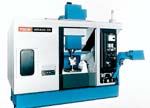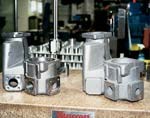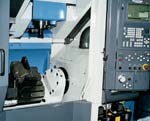Manufacturer Halves Cycle Times With Machining Center
The complex shapes of the iron castings that make up the housings for this company's flow meters require machining on multiple faces. The castings undergo various types of machining operations, from drilling to helical thread milling.
Share





Liqua-Tech has a strong reputation as a small, high quality manufacturer of liquid-propane flow meters. The Ukiah, California, company's meters, which are used to meter liquid propane at rates from 3 to 100 gallons per minute and feature durable cast-iron housings, are sold throughout the world.
The complex shapes of the iron castings that make up the housings for Liqua-Tech's flow meters require machining on multiple faces. The castings undergo various types of machining operations, from drilling to helical thread milling. Just about every side receives some type of machining operation. To present each side at the proper orientation to the necessary tool, the casting workpiece must be rotated and tilted at different times during the machining cycle. Previously an older machining center performed the actual machining while a manual tilt-rotary table indexed by an operator manipulated the part. The machining cycle incorporated many pauses to allow the operator to open the machine door, index the part, check part placement, close the door, and then restart the machine.
According to Brent Christensen, director of engineering, it was time for a change. "The machine had served its purpose well but was basically old technology. We were also seeing greater production demands from our distributors." While its competitors were eager to provide lower-cost meters made with easier- and faster-to-machine aluminum housings, Liqua-Tech would not take that route. The company's focus was to maintain the high quality of its product and still compete on price with its competitors.
As pallets of castings were piling up, Mr. Christensen finally found what he was looking for at a Santa Clara, California tool show. While passing the Mazak (Florence, Kentucky) booth at the show, Mr. Christensen saw a Variaxis 200 in action and saw exactly what he wanted. "I saw this machine maneuvering an aluminum part around, just the way I wanted to manipulate our parts."
Eager to see how well the Variaxis would tackle the cast-iron housing machining, Mr. Christensen began playing with its operation the moment it was installed. Within 2 days the machine was programmed and machining production parts. Initial testing involved face milling and the drilling and tapping of bolthole patterns. That success quickly led to the more complex machining required on the actual housing of one of the company's key products.
"The model LPM-102 flow meter receives machining on the top two surfaces, the sides and the bottom," explains Mr. Christensen. "The part then needs tilting and rotating for the tools to hit another side at a 45-degree angle. The Variaxis did all this in a single fixturing."
On the older system, tilting and rotating of the part was done manually. The old machining center would perform all milling, drilling and tapping operations on a single side, after which the operator would index the part to the next orientation, and the machine would repeat the process using as many tools as needed.
The flexible part manipulation possible on the Mazak actually shortened the programming necessary to machine the housings. This was due to the reduction of tool changes in the cycle. According to Mr. Christensen, "Now we grab a face mill and mill everything that requires face milling, with the tilt rotary table quickly positioning the part as needed. Then we grab the center drill and center drill all those features requiring center drilling. We continue in this way until the part is done. We are no longer grabbing tools multiple times as we did with the previous machine."
The single fixturing, while an important consideration, was enhanced by the faster cutting speeds and feeds possible with the new machining technology offered by the Variaxis. "On some of our parts it knocked our production times down by half, if not more," says Mr. Christensen. Work that took an hour to machine on the older machine initially took 28 minutes on the Mazak. This initial work, without fine tuning of the cutting parameters, already delivered an impressive 53-percent reduction in cycle times.
These features enabled the company to quickly catch up on its orders while running the new machine for only one shift per day. Over the last few months since the installation of the new machine, Mr. Christensen views production changes at Liqua-Tech as night and day. "Not having had any direct experience with one, it was a leap of faith to go with this Mazak machine. But we are really happy with it. The spindle speeds, the rapid travel, toolchange time—everything is fast."
Everyone in the shop is excited with the flexibility and capabilities of the new machine. Their key focus is on setup reductions. Supervisors and operators often approach Mr. Christensen with ideas on how the machine could save setup times on other in-house jobs.
The faster cycle times, fewer setups and longer tool life delivered by the Variaxis have allowed Liqua-Tech to maintain its competitiveness in the propane industry. "Not only have we doubled production rates, but we now have a machine available to do other work where otherwise it would have been tied up. Overall, this investment has made a world of difference to us."
Related Content
6 Machine Shop Essentials to Stay Competitive
If you want to streamline production and be competitive in the industry, you will need far more than a standard three-axis CNC mill or two-axis CNC lathe and a few measuring tools.
Read MoreInverting Turning and Five-Axis Milling at Famar
Automation is only the tip of the iceberg for Famar, which also provides multitasking options for its vertical lathes and horizontal five-axis machine tools.
Read MoreBallbar Testing Benefits Low-Volume Manufacturing
Thanks to ballbar testing with a Renishaw QC20-W, the Autodesk Technology Centers now have more confidence in their machine tools.
Read MoreHow to Determine the Currently Active Work Offset Number
Determining the currently active work offset number is practical when the program zero point is changing between workpieces in a production run.
Read MoreRead Next
Registration Now Open for the Precision Machining Technology Show (PMTS) 2025
The precision machining industry’s premier event returns to Cleveland, OH, April 1-3.
Read More5 Rules of Thumb for Buying CNC Machine Tools
Use these tips to carefully plan your machine tool purchases and to avoid regretting your decision later.
Read MoreSetting Up the Building Blocks for a Digital Factory
Woodward Inc. spent over a year developing an API to connect machines to its digital factory. Caron Engineering’s MiConnect has cut most of this process while also granting the shop greater access to machine information.
Read More


























.jpg;maxWidth=300;quality=90)









.jpg;maxWidth=970;quality=90)